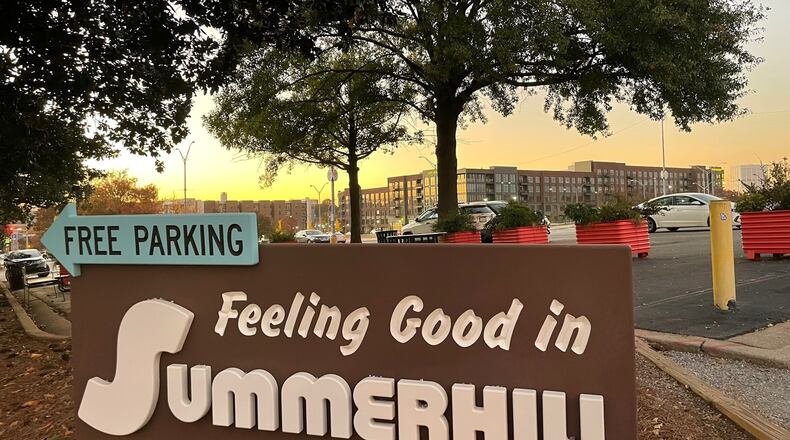It turns out the Braves fleeing Atlanta was the best thing to happen to the Summerhill neighborhood.
Sure, Cobb County harpooned a whale of a project, snagging the Braves (perhaps it was the other way around, what with $300 million-plus in taxpayer money needed to lure them). But with a World Series title in tow, the debates about corporate socialism have dissipated. And you can now devour artisanal pizza and quaff a craft beer at the Braves’ new playground, The Battery.
Back on Georgia Avenue, the ghost town that once adjoined Turner Field is alive. You can sip an espresso, lick locally sourced ice cream and down smoked prime brisket. The hated cliché “win-win” was used to describe the development in Cobb and in the area they left behind. But a twin victory connected with any Atlanta sports team is a headline.
As a longtime Braves season-ticket holder, I used to park a mile from the ballpark (I’m cheap) and stroll past blocks of boarded-up storefronts on Georgia Avenue, wondering, “Why isn’t anything here?”
Credit: Curtis Compton
Credit: Curtis Compton
There were two reasons: One, the Atlanta-Fulton County Recreation Authority, which owned the ballpark and vast expanses of land for parking, was historically bad about getting things accomplished. And two, a man named John Elder owned most of the storefronts, having quietly gobbled up most of the old business district. However, he wasn’t that motivated to bring in businesses because he owned many lots where he parked cars for the ballgames and pocketed wads of cash.
In 2013, I had a question: What’s his deal? Elder wasn’t talking, so I perused tax records and found dozens of his properties. As I readied to write then, Rebecca Burns of Atlanta Magazine scooped me and wrote a splendid story called “The Other 284 Days.” It described the inner workings of local politics and how on 81 days (mostly nights) a year, the Braves brought 30,000 people to Summerhill. But on the other 284 days, trash blew across the acreage left fallow for parking.
Burns explained what Elder was up to and wrote the Braves were negotiating with the Rec Authority, wanting “control” of the area. Thoroughly beaten, I limped away from that story. Four months later, in November 2013, I returned to Summerhill after the Braves announced the shocking news that they were skedaddling.
Several residents complained the team had decimated the neighborhood twice in the previous half-century, uprooting hundreds of homes and families to build two stadiums and leaving a wasteland. Now, they said, the jobs afforded to the low-income families living there were vanishing, too.
But resident Kenyatta Mitchell saw opportunity.
“I think we’re in a better place,” she said in 2013. The residents had long wanted to create some neighborhood amenities, but there was a problem. “Before, all our ideas had to work around Braves parking.” Now, she added, they were free of such restraints.
This week, Mitchell sounded happy how things worked out. Georgia Avenue, the neighborhood’s main thoroughfare, is hopping. Young families are moving in, a Publix is getting built and side streets, long closed for the vast parking lots, are being rebuilt.
“It is starting to feel like a neighborhood again,” she said. Although, she added, not everyone feels included. “Some folks think the neighborhood has slipped away from them; they can’t afford or don’t want to eat Thai food or artisanal food.”
The Atlanta firm Carter has headed up the area’s redevelopment, working with Georgia State University, which now fields a football team in the old Turner Field and has built 700 student apartments.
Carter’s new office is in a Georgia Avenue building once owned by John Elder, and the street is now filled with people and stores with their doors open and lights on.
David Nelson, a Carter exec, said almost 900 apartments are being built, meaning that 1,500 to 2,000 people will be walking the streets, breathing more life into the community. That’s not to mention the blocks of swanky townhomes going up.
“When we came, we asked, ‘From a retail perspective, what was needed?’ People said, ‘Well, everything,’” Nelson said. He said the entire footprint is about 83 acres, plus another 10 acres that is privately owned. In all, there’s been $780 million invested.
Credit: Bill Torpy
Credit: Bill Torpy
“It seemed like the wind was at our back,” Nelson said. “Everyone wanted something good to happen here.” People root for the jilted partner.
As to John Elder, he died in 2013 and his properties were sold off in an auction. Carter bought them.
Elder’s friend, attorney Ed Bowen, said Elder got creamed by the Great Recession. Elder was a victim of “bad timing,” he said. “But John would be happy looking at all this.”
About the Author
Keep Reading
The Latest
Featured




